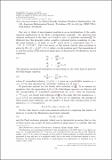| dc.contributor.author | Guillemin, Victor W | |
| dc.date.accessioned | 2018-05-22T17:31:38Z | |
| dc.date.available | 2018-05-22T17:31:38Z | |
| dc.date.issued | 2013-04 | |
| dc.identifier.issn | 0273-0979 | |
| dc.identifier.issn | 1088-9485 | |
| dc.identifier.uri | http://hdl.handle.net/1721.1/115557 | |
| dc.description.abstract | One way to think of semi-classical analysis is as an investigation of the mathematical implications of the Bohr correspondence principle: the assertion that classical mechanics is the limit, as tends to zero, of quantum mechanics. | en_US |
| dc.publisher | American Mathematical Society (AMS) | en_US |
| dc.relation.isversionof | http://dx.doi.org/10.1090/S0273-0979-2013-01409-5 | en_US |
| dc.rights | Article is made available in accordance with the publisher's policy and may be subject to US copyright law. Please refer to the publisher's site for terms of use. | en_US |
| dc.source | American Mathematical Society | en_US |
| dc.title | Book Review: Semi-classical analysis | en_US |
| dc.type | Article | en_US |
| dc.identifier.citation | Guillemin, Victor. “Book Review: Semi-Classical Analysis.” Bulletin of the American Mathematical Society, vol. 50, no. 4, Apr. 2013, pp. 681–83. © 2013 American Mathematical Society | en_US |
| dc.contributor.department | Massachusetts Institute of Technology. Department of Mathematics | en_US |
| dc.contributor.mitauthor | Guillemin, Victor W | |
| dc.relation.journal | Bulletin of the American Mathematical Society | en_US |
| dc.eprint.version | Final published version | en_US |
| dc.type.uri | http://purl.org/eprint/type/JournalArticle | en_US |
| eprint.status | http://purl.org/eprint/status/PeerReviewed | en_US |
| dc.date.updated | 2018-05-22T15:01:56Z | |
| dspace.orderedauthors | Guillemin, Victor | en_US |
| dspace.embargo.terms | N | en_US |
| dc.identifier.orcid | https://orcid.org/0000-0003-2641-1097 | |
| mit.license | PUBLISHER_POLICY | en_US |
